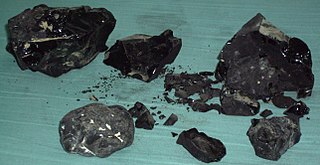
Bitumen is an immensely viscous constituent of petroleum. Depending on its exact composition it can be a sticky, black liquid or an apparently solid mass that behaves as a liquid over very large time scales. In the U.S., the material is commonly referred to as asphalt. Whether found in natural deposits or refined from petroleum, the substance is classed as a pitch. Prior to the 20th century the term asphaltum was in general use. The word derives from the ancient Greek ἄσφαλτος ásphaltos, which referred to natural bitumen or pitch. The largest natural deposit of bitumen in the world, estimated to contain 10 million tons, is the Pitch Lake of southwest Trinidad.
Coal tar is a thick dark liquid which is a by-product of the production of coke and coal gas from coal. It is a type of creosote. It has both medical and industrial uses. Medicinally it is a topical medication applied to skin to treat psoriasis and seborrheic dermatitis (dandruff). It may be used in combination with ultraviolet light therapy. Industrially it is a railroad tie preservative and used in the surfacing of roads. Coal tar was listed as a known human carcinogen in the first Report on Carcinogens from the U.S. Federal Government, issued in 1980.
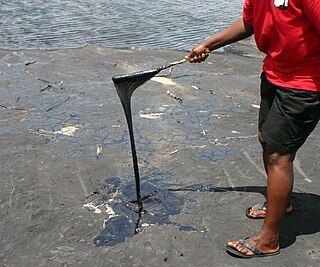
Tar pits, sometimes referred to as asphalt pits, are large asphalt deposits. They form in the presence of oil, which is created when decayed organic matter is subjected to pressure underground. If this crude oil seeps upward via fractures, conduits, or porous sedimentary rock layers, it may pool up at the surface. The lighter components of the crude oil evaporate into the atmosphere, leaving behind a black, sticky asphalt. Tar pits are often excavated because they contain large fossil collections.

The La Brea Tar Pits is an active paleontological research site in urban Los Angeles. Hancock Park was formed around a group of tar pits where natural asphalt has seeped up from the ground for tens of thousands of years. Over many centuries, the bones of trapped animals have been preserved. The George C. Page Museum is dedicated to researching the tar pits and displaying specimens from the animals that died there. La Brea Tar Pits is a registered National Natural Landmark.

Mayaro is the name of a county on southeastern Trinidad island, in Trinidad and Tobago.

Petroleum Company of Trinidad and Tobago Limited was a state-owned oil company in Trinidad and Tobago. Its principal activities were the exploration, development and production of hydrocarbons in addition to the manufacturing and marketing of petroleum products.
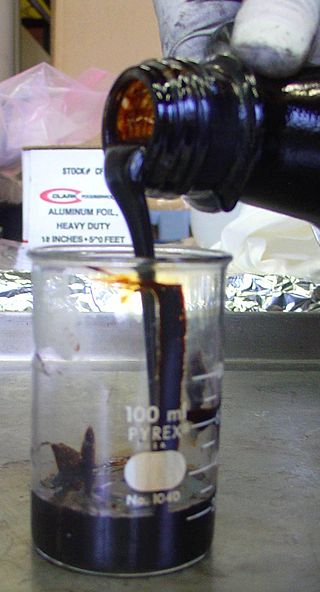
Tar is a dark brown or black viscous liquid of hydrocarbons and free carbon, obtained from a wide variety of organic materials through destructive distillation. Tar can be produced from coal, wood, petroleum, or peat.
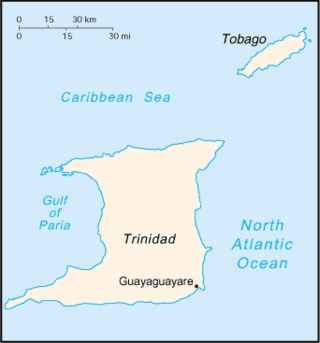
Guayaguayare is the southeasternmost village in Trinidad & Tobago. It lies at the southern end of the county of Mayaro. Guayaguayare is primarily a fishing village, but it also plays a major role in the petroleum industry. The largest petroleum producers in the country - BP Trinidad & Tobago (bpTT), BHP and Petrotrin all have major presences here and bpTT controls the Port of Guayaguayare, which services most of the offshore petroleum production in Trinidad. The major natural gas pipelines, serving Atlantic LNG in Point Fortin and the Point Lisas Industrial Estate, come ashore here.
Couva is an urban town in west-central Trinidad, south of Port of Spain and Chaguanas and north of San Fernando and Point Fortin. It is the capital and main urban centre of Couva–Tabaquite–Talparo, and the Greater Couva area includes the Point Lisas industrial estate and the port of Point Lisas. It is one of the fastest-growing towns in the country. Couva's southern boundary is at the village of California and Point Lisas, and to the north Couva stretches to McBean. To the east of Couva is Preysal. To the west of Couva is the road to Waterloo and Carli Bay, which are located on the Gulf of Paria. Couva was part of the Caroni County. Couva is considered a major power base for the United National Congress, whose headquarters was previously located here.

The Pitch Lake is the largest natural deposit of asphalt in the world, estimated to contain 10 million tons. It is located in La Brea in southwest Trinidad, within the Siparia Regional Corporation. The lake covers about 100 acres and is reported to be 250 feet deep.
Alphonso Philbert Theophilus "Fargo" James, born in Black Rock, Tobago, was a Trinidad and Tobago politician. He was elected to the Legislative Council in 1946. He served in the Legislative Council until 1961 when he was defeated by A. N. R. Robinson. James was known as "Fargo", after a brand of trucks, because of his strength and tendency to crush opponents. He was known as being a proponent of Tobagonian secession from Trinidad and Tobago.

A petroleum seep is a place where natural liquid or gaseous hydrocarbons escape to the earth's atmosphere and surface, normally under low pressure or flow. Seeps generally occur above either terrestrial or offshore petroleum accumulation structures. The hydrocarbons may escape along geological layers, or across them through fractures and fissures in the rock, or directly from an outcrop of oil-bearing rock.

Hancock Park is a city park in the Miracle Mile section of the Mid-Wilshire neighborhood in Los Angeles, California.
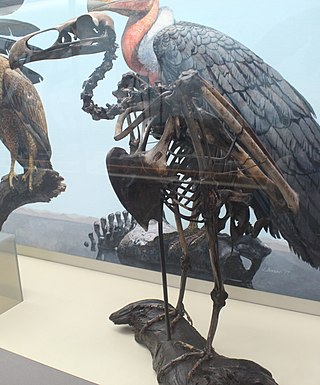
Teratornis was a genus of huge North American birds of prey—the best-known of the teratorns—of which, two species are known to have existed: Teratornis merriami and Teratornis woodburnensis. A large number of fossil and subfossil bones, representing more than 100 individuals, have been found in locations in California, Oregon, southern Nevada, Arizona, and Florida, though most are from the Californian La Brea Tar Pits. All remains except one Early Pleistocene partial skeleton from the Leisey Shell Pit near Charlotte Harbor, Florida date from the Late Pleistocene, with the youngest remains dating from the Pleistocene–Holocene boundary.

The Southern Main Road is a major road in Trinidad and Tobago running from Curepe in the north through Chaguanas, Couva, San Fernando, and Point Fortin to Icacos in the southwest, over a now discontinuous length of 120 km.

The McKittrick Tar Pits are a series of natural asphalt lakes situated in the western part of Kern County in southern California. The pits are the most extensive asphalt lakes in the state.

Lake Asphalt of Trinidad and Tobago is a company based in La Brea in Trinidad involved in the mining, processing and exporting of asphalt products from the Pitch Lake.



















